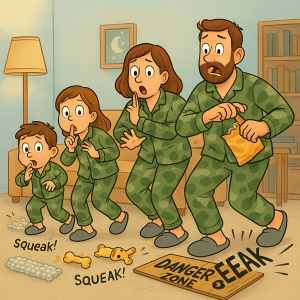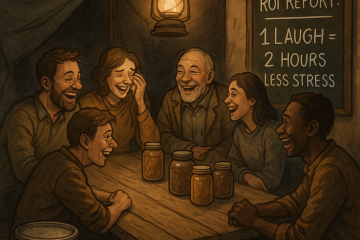
Sound discipline is a real thing.
Let’s be honest: silence in a household is usually only achieved when everyone’s asleep… or hiding from chores. But in a grid-down scenario, learning to manage noise isn’t just about peace and quiet—it’s about awareness, courtesy, and not sounding like you’re throwing a cymbal solo every time you go for a midnight snack.
This isn’t about becoming paranoid or living like a ninja monk. It’s about building a little self-discipline, because let’s face it: bad actors do exist, and sometimes the best way to stay out of trouble is to avoid drawing attention in the first place. That goes for strangers and neighbors who suddenly develop an unhealthy interest in your stash of instant mashed potatoes.
Let’s dive in—quietly—into some practical and yes, entertaining ways to help your household adopt their Inside Apocalypse Voices without turning your home into a library run by Navy SEALs.
Why Noise Discipline Matters—Even When It’s Not Life or Death
When the lights go out and the hum of modern life disappears, sound takes center stage. You notice every floor creak, every cabinet slam, every cousin Todd clearing his throat like he’s doing a TED Talk on sinuses.
Noise discipline isn’t just for hiding. It’s also about being considerate in close quarters, reducing stress, and maintaining calm when things around you are already a bit “high-strung violin solo.”
Whether you’re in a shared space, a tight neighborhood, or just trying not to wake up the baby (again), learning to live a little quieter can pay off—no ninja training required.
Five Practical Ways to Teach Inside Apocalypse Voices
1. Introduce a “Library Hour” (But Cooler)
Designate a time each day to practice low-volume living. Make it a game: who can move around without being heard? Who can cook a snack in stealth mode? The winner gets the good granola bar—the one with chocolate chips and moral superiority.
It’s not about fear; it’s about muscle memory. If your household knows how to function quietly during calm times, they’ll be better equipped when things get tense.
2. Rethink Your Gear—Especially the Loud Stuff
Velcro, I’m looking at you. You traitor. Nothing says “I’m here and I brought snacks” like a rip of tactical Velcro in the dead of night.
If you’ve got gear with noisy closures, consider alternatives: zippers with paracord pulls, silent snaps, even the old-fashioned button (remember those?). And while we’re at it, maybe don’t store all your tools in a rattly metal box that sounds like a rockslide when opened.
Practical, not paranoid. Just less clangy.
3. Master the Art of Quiet Snacking
If you’ve ever tried opening a granola bar during church, a funeral, or a sleeping baby situation, you already know the stakes.
Prepping for quieter snacking just means thinking ahead:
-
Unwrap noisy items and repackage them in wax paper or cloth bags.
-
Keep quiet snacks on hand (dried fruit, jerky, even muffins—quiet and delicious multitaskers).
-
Create a “crinkle-free” snack zone in your pantry with repackaged favorites.
Because no one wants their apple chip moment to sound like a horror movie jump scare.
4. Get the Kids Involved—with Games, Not Guilt

stealth snack squad
Turn stealth into a game!
-
“Ninja Tag”: barefoot, slow-motion hide and seek.
-
“Spy School”: practice moving silently, using hand signals, and yes—using inside voices.
-
“Quiet Time Olympics”: winner is whoever can do three tasks the quietest (like stacking canned goods or cleaning up Legos—with a whisper).
You’ll not only help them burn off some cabin fever, you’ll be planting seeds for calm-under-pressure behavior—without the drama.
5. Use Signals and Codewords (But Keep it Lighthearted)
Ever tried telling someone across the room to stop talking without using words? That’s called Tuesday in a big family.
Create a few fun hand signals or goofy codewords for “quiet down,” “someone’s outside,” or “stop rustling that chip bag like you’re being chased by squirrels.” Keep it playful, not paramilitary. Laughter helps lessons stick.
We used to use “Unicorn Protocol” for “hush now, guests are coming” and my nephew thought we were running a spy ring. He’s now a grown man who can walk across a squeaky floorboard like a ghost. Win.
Introspection (The Soft, Non-Crunchy Kind)
Noise discipline isn’t about panic. It’s about presence. It teaches us to be intentional—how we move, how we speak, how we interact with the world when things are fragile.
And in a family or group setting, it also builds trust. You’re saying, “I’m watching out for you, and I trust you to do the same.” That kind of connection? Way louder than any Velcro strap could ever be.
Final Thought (Delivered in a Whisper)
The world gets noisy. Life gets chaotic. But the prepared person knows that sometimes the strongest move is a quiet one.
So go ahead—train your household to use their inside apocalypse voices. Not out of fear, but out of readiness. Because while others are announcing their presence with every snack and stomp, you’ll be sipping herbal tea in serene silence, your pantry un-pillaged and your nerves intact.
And if you do open that granola bar too loudly? Just shrug and say, “Oops. Guess I failed the snack stealth module.” Then hand one over to your spouse and remind them, “This is why we practice.”



1 Comment
Louise · May 23, 2025 at 3:33 pm
When I was growing up a suddenly raise hand meant, “listen!”. Everyone would a
top talking and strain their ears to hear – it usually was a bear outside or someone in our town on the CB calling for help.
Comments are closed.